Nov. 2022. The Bon Pastor’s Spiral


Nov. 2022. The Bon Pastor’s Spiral



organized by
The University of Lodz [Department of Ethics/Institute of Philosophy]
The University of Barcelona [Polis Research Centre]
The Urban Forms Foundation
The Conference will be held at the Institute of Philosophy at the University of Lodz, 3/5 Lindleya Street, on 12th–14th September 2022.
[Due to the developing Covid-19 pandemic, we are considering the possibility of conducting an entirely online conference. If it is possible, we are ready to organize both virtual and live sessions]
AIMS & TOPICS
The city is usually full of opposites. It is important especially now as we face the challenges of the Sustainable Development Goals (the 2030 Agenda for Sustainable Development) which will surely have an impact on the ways of “building a city”. In a living city, something always changes, but there are also elements that function permanently or relatively permanently. It seems that the oscillation between what is static and dynamic is an inherent feature of the city. The experience of this diversity or polarization manifests itself in various aspects, not only historical, but above all axiological. We differentiate and value what is:
The different qualities can be internalized as values and hierarchized in various ways. Dynamics can be understood not only positively, but also destructively, because even such an aspect may generate qualities considered as positive after some time. These aspects include both modernization and reconstruction, and on the other hand, ruins, expansion of natural forms. In spite of the obvious volatility, don’t we expect a balance between what is permanent and what is changeable? How much can one allow oneself to introduce changes or modifications (perhaps it is not always worth to protect everything)? What changes are more readily accepted: functional or visual? What changes are more advantageous to our cities?
ABSTRACTS
Please submit your abstract via email using attached AEC5-Registration-form. Abstracts will undergo a peer review for selection or rejection by the conference committee.
A printed publication of the Conference abstracts will be available at the Conference. Only the attending and registered delegates are going to be published. All abstracts (maximum of 400 words) must contain the title of the proposed paper, the name of the author, a brief cv including current affiliation and the contact information (institutional affiliation, mailing address and email address).
PRESENTATIONS
All accepted and registered delegates will be presenting their papers at the Conference.
Presentations will be organized in sessions or panels of no more than 4 papers presented for 20 min and all followed by a 30 minute debate.
FULL PAPERS
The publication of full papers will be prepared after the Conference and authors will be notified if their papers are selected for further publication. Depending on the subject, we offer printing selected, double-reviewed papers in magazines: “On the w @terfront” (University of Barcelona), “Acta Universitatis Lodziensis. Folia Philosophica. Ethica – Aesthetica – Practica” (University of Lodz). See our previous papers.
REGISTRATION
All attending delegates must proceed with Registration and fee payment in order to present their papers at the Conference.
CONTACT
Agnieszka Gralińska-Toborek Ph.D (Conference Secretary)
aestheticenergycity@uni.lodz.pl
Wioletta Kazimierska-Jerzyk Ph.D (Conference Chair)
wioletta.kazimierska@uni.lodz.pl

Emilio Reyes-Schade, Katheryn Gutiérrez-Torres, Padilla-Llano Samuel Esteban
Centrados en el sentido de urbanidad, el presente artículo se ha planteado como una aproximación a la capacidad de transformación que tiene el binomio sistema de espacio público – sistema de transporte público, en los procesos de reestructuración y/o recualificación urbana en distintos contextos geográficos. Lo anterior, se aborda en términos de la subsanación o del reacomodo morfológico de ciertas rupturas que presenta el tejido urbano frente a la idea del espacio público como sistema polisémico de articulación, estructuración y soporte de la ciudad. Los aportes urbanos suscitados a partir de la reimplementación del transporte público guiado en la ciudad, pueden apreciarse a la luz del análisis del caso del canal tranviario de Ayacucho en la ciudad de Medellín, actuación urbana que ha representado una herramienta significativa de “hacer ciudad”, de la cual se concluye que se ha consolidado como una pauta de crecimiento que ha permitido, a su vez, proyectar con cierto grado de certeza un desarrollo urbano en un tiempo consensuado a partir de políticas públicas. Esta intervención ha posibilitado también la conformación de un ambiente urbano flexible (polivalente), propicio para la generación de intercambios espontáneos y la reconexión entre las instancias (actividades y lugares) urbanas que presentaba el tejido urbano con las nuevas instancias urbanas que se han generado a partir de la implementación del tranvía.
A new book by Rosa Vives
Trilogy about Several Urban View and Landscape Prints presents three essays dedicated to the specific observation of prints, by great artists such as Canaletto, Goya, Hokusai and Picasso, whose main theme is the representation of outdoor space: landscapes and urban views. M. Rosa Vives studies the contextualisation of these prints and their creative and iconographic links with tradition, and with other artists and creative media. The works remind us that engraving has been, and continues to be, an artistic medium with its own language, a particular technology, and a sensorial form of expression and communication. They also recall how, before the advent of photography, engraving was a major force behind the spreading of images and culture.
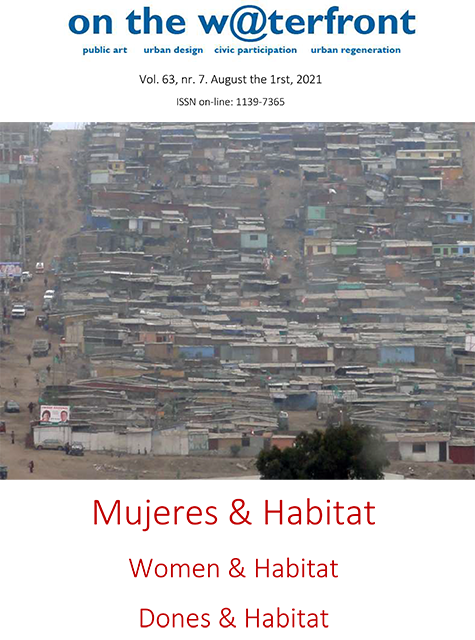
The Woman Builds. ‘Architecture Na Periphery’
Participation for the intervention and transformation of the environment, in the case study Arquitectura Na Periferia”, is presented as an emancipatory way for women and to mitigate conflicts of different kinds in marginalized settlements.
This article studies the broader consequences of citizen participation and collaboration in practices that break the usual operational schemes of the architectural and urban discipline.
In this way, it is intended to carry out, at the same time, an evaluation of some renewed professional practices, reviewing the attitudes and action procedures and demonstrating the efficiency of the processes in which the people and communities involved grow and transform.
https://doi.org/10.1344/waterfront2021.63.7.01
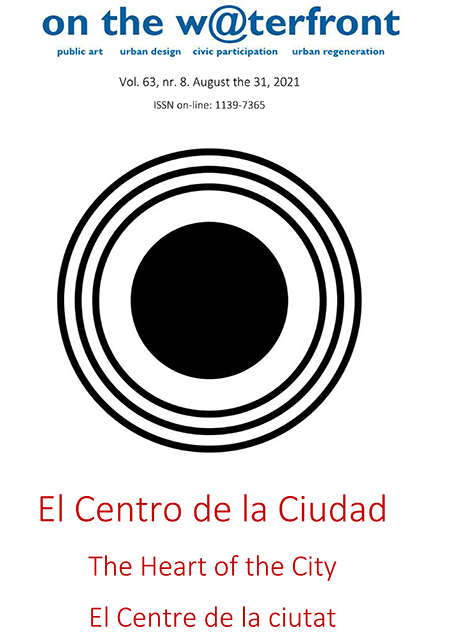
Searching for the center. First part
This article, the first part of a series, reviews the idea of the ‘center’ of the city through an analysis of some utopian proposals, including Howard’s for the garden city and ends with an analysis of the polycentrality of the medieval city.
After a review of the evolution of circular and polygonal cities from an analysis of secondary
sources, artistic iconography, cartography of the early days of printing and images of Google Earth, introduces the discussion about the ‘ideal city by studying this concept in medieval scholasticism, especially in the work of Eiximenis, as well as the relationship of this ideal with the materialization of the medieval cities [1] of repopulation, valuing the relationship between the routes and the emergence of the urban center and [2] the study, with different
intensities, of important medieval cities: Siena, Bologna, Florence, Venice, Brussels, Krakow,
Naples and Barcelona.
In the case of these last two cities, the article focuses on the importance of the port and shore space, as a large public space in the city.
https://doi.org/10.1344/waterfront2021.63.8.01
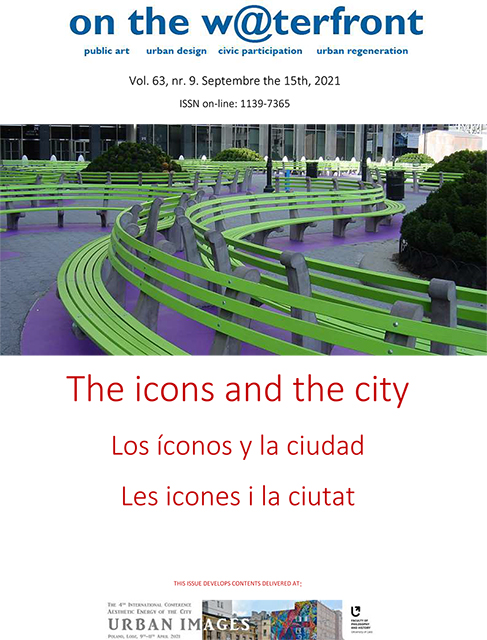
Aesthetic Uniqueness of Public Space. Based on the Example of the Region of Łódź(Poland) Basic Terminological Issues
Jowita Mróz Doctoral School of Humanities. University of Łódź
The concept of uniqueness can be an important critical tool. But as related to architecture, buildings, or the entire architectural and visual landscape of the city it appears frequently in many different contexts.
One can state that describing objects in public space and even entire urban complexes in terms of uniqueness plays a marketing role – it increases the tourist attractiveness of the area – as well as socio-cultural role, because it helps to strengthen the city and build its community’s sense of identity. Indicating these goals or the intention to create uniqueness in the region of Łódź draws attention to another, more fundamental theoretical-linguistic issue, namely, what it means that something is unique.
Taking into account etymology, theoretical approach, as well as possible values attributed to ‛uniqueness,’ I will consider main terminological problems with the notion. Bearing in mind these basic theoretical-linguistic issues, I will consider whether there are unique objects in the city of Łódź and the region.
Trying to answer this question I will review phenomena and objects that could be considered as unique. Identifying possible uniqueness of the places and objects located in public spaces of the region of Łódź, I will consider what can create a unique panorama of urban space in Łódź and its region, and on what scale this uniqueness can be considered in order to avoid the feeling that in some sense everything is unique, or nothing is, because it imitates or resembles existing solutions, ideas in other cities of Poland or Europe.
https://doi.org/10.1344/waterfront2021.63.9.01
The image of contemporary architecture of Wrocław depicted in recent tourist commercial and Internet media
Natalia Bursiewicz Pedagogical University of Krakow
ABSTRACT
The aim of the paper is to present the tourist and image potential of contemporary public architecture.
Wrocław was chosen as the research subject, as it is a historical center with an extremely rich architectural heritage, which has enjoyed great interest among visitors for centuries. With the announcement of Wrocław as the European Capital of Culture 2016, and then the European Best Destination in 2018, its attractiveness increased significantly, which was reflected not only in the number of visitors, but also in the advertising materials themselves.
Both before and after arrival, millions of tourists encounter a multitude of various advertising forms, both virtual and printed, which determine the direction of sightseeing and shape a specific image and perception of the city. In general opinion, Wrocław is considered a historic city, the most interesting places of which are concentrated around the Old Town and Ostrów Tumski. The Centennial Hall, built at the beginning of the 20th century, stands out from the „newer heritage”.
The idea of the study, however, was to answer the question whether contemporary architecture is used in any way in the current tourist advertisement of the city. Another goal was to identify and list the most frequently appearing objects from the adopted group, and to analyze the manner of their presentation. Based on the collected materials, efforts were made to assess the role of the media in creating a tourist product in terms of promoting local architecture in recent years.
At the same time, an attempt was made to evaluate the role of architecture in creating the city’s progressive brand. In the research, the author used the method of analyzing the existing statistical data, iconographic research and the method of analyzing the content of advertising materials, as well as scientific studies on cultural heritage and tourism in the city. The final part of the paper shows that modern architecture can be a significant element increasing the tourist attractiveness of the city.
Organized by the Society of Friends of Drawing and Engraving with the support of the San Fernando’s Royal Academy of Fine Arts, have made public the awards for the 2021 edition. Among the winners, our colleague, Professor Rosa Vives.

The Ceán Bermúdez Award for the Arts of Drawing, Engraving and Illustrated Book distinguishes individuals and corporations, institutions, legal persons, organizations or public or private entities that have excelled in the field of artistic and cultural creation or have lent Notorious services in the promotion, development, trade, collecting or dissemination of the arts of drawing, printing and illustrated books.
JUAN AGUSTÍN CEÁN BERMÚDEZ (Gijón 1749 – Madrid 1829) He was the prototype of the illustrated scholar, a fundamental character for the history of Spanish art, a kind of catalyst for very diverse aspects in this field such as historiography, art criticism, collecting, the history of painting, of architecture. and Spanish sculpture, and also engraving. Not only did he maintain a close relationship with Goya and other artists of the time, but he was also a fundamental piece in the circle of politicians and intellectuals such as Jovellanos, Iriarte, Moratín, Vargas Ponce and many others who tried to regenerate the country through the education, culture, economics or politics.
The awards ceremony will be on October 1, Friday, at the Real Academia de Bellas Artes de San Fernando (Madrid).
By José Antonio De Gracia DOI: https://doi.org/10.1344/waterfront2021.63.6.01
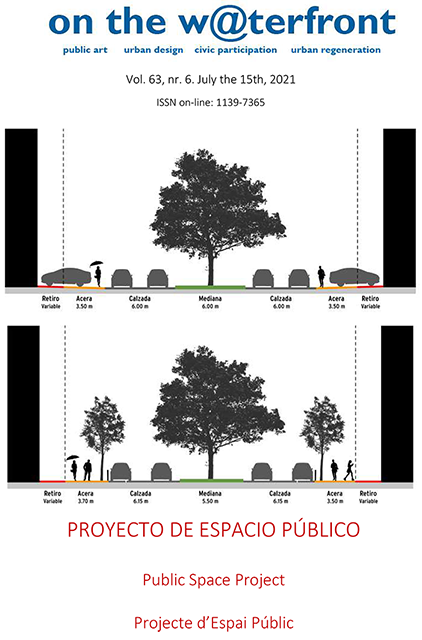
This article uses an urban intervention in Panama City to discuss fundamental concepts in public space projects from a critical and theoretical perspective.
First, the functions of the street as a basic structure of public space are illustrated. Its importance is recognized not only as an element of urban connectivity, but also as a place of movement, encounter, support and creation of urban meanings and social identities.
Secondly, our case study is contextualized: the urban renewal of via Argentina, a street in the urban center whose environment was in a state of degradation like most streets in the city, largely occupied by the presence of vehicles. The intervention is part of a series of urban projects aimed at improving the physical structure of the city.
The third section begins a critical analysis of the actions on Via Argentina, starting with the redistribution of street space, the relationship between vehicles and pedestrians, and the consolidation of public space.
Next, we discuss in detail the new primary elements used for the urbanization of the street. Curbs, fords, pavement, rigola, gutters, tree surrounds and bollards become part of a system that must maintain a coherent relationship between all its parts. In addition, emphasis is placed on the design of the ground and the application of the pavement as a tool for the construction of an urban image and identity.
Finally, the article ends with an analysis of the parameters of accessibility in the project, relating the concept to the use of the pavement and the configuration in some sections of the street as a single platform. The article uses a wide repertoire of documentary photography to contextualize the case study.
Urban design; Public space; Pavement; Universal accessibility; Single platform; Via Argentina; Panama City.
We got rank in SCOPUS

in the area of Art and Humanities (Visual Arts and Performing Arts)-
And in

By -Zoltán Somhegyi DOI: https://doi.org/10.1344/waterfront2021.63.4.01
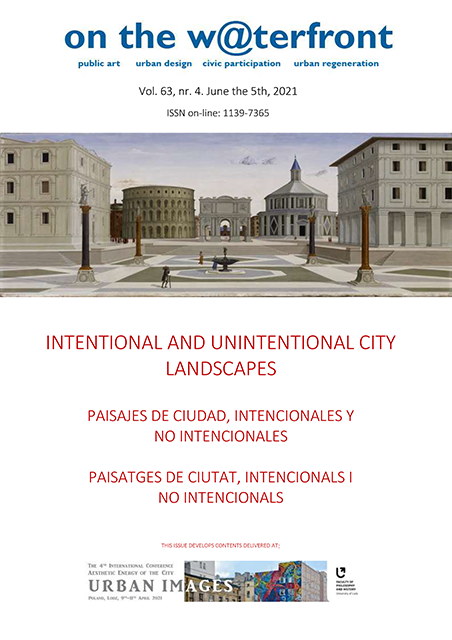
Cities have been inspirational for the creators of visual art works long since, first as mere secondary, additional motifs to indicate the “urban” environment of the main scene, then as subject-matters in their own right. Those images could depict both imaginary and actual cities of the past and of the future, including mythological and Biblical locations, documenting distant lands and fantasizing on the appearance of utopian cities. In some of these aspects, the history of city representations shares significant similarities with the history of landscape depictions.
In the present paper, however, I aim to focus on a curious and particular detail in this pictorial tradition. Following and further investigating a brief reflection by Michel Makarius from his 2004 book on Ruins, I would like to compare the visuality and aesthetic effects of dense and empty cityscapes, of which two classical examples could be the capriccios – imaginary views of cities completely filled with aesthetically pleasing elements, including magnificent remnants of the Antique heritage – and representations of cities in which their emptiness is highlighted to such extent that the observer tends to assume that the real subject-matter of the image is not the city, its buildings, forms and physical components but exactly its being “empty”.
These “extremities” on the broad range of cityscapes, i.e., the densely-filled and the extremely depopulated are, however, not merely historical sub-genres of long-gone centuries. These typologies have survived to this day, in various versions and with diverse accents; what’s more, they seem to be more relevant than ever in understanding not only the nature of these artistic representations and their aesthetic references, but also in learning more of our contemporary reality itself. It is enough to think of the numerous ways in which artists approach the convoluted issues and challenges of urban life today, with the classical references and visual vocabulary in mind, either unconsciously creating occasional parallels or using them as explicit forerunners to their own works. The density of the global megapolises are represented in artistically novel ways often with socially critical overtones, while the images of empty cities – not long ago, for example, during the recent pandemics and lockdowns – are again resulting in aesthetically inspiring and insightful works incentivizing us to reflect on the oscillating dynamisms of our present urban realities. Therefore, it is particularly beneficial to observe such renderings of our cities and hence to raise more our awareness of the multiple global issues that are often very strongly manifested in the everyday life in large metropolises. Pieces of art thematising the extreme forms of city life can become very efficient ways of constantly reminding us of our duties of taking care of both our cities and our life.
representations of cities; dense cityscapes; empty cities; aesthetics of urbanity
 2019 vol. 61/3
2019 vol. 61/3
You must be logged in to post a comment.